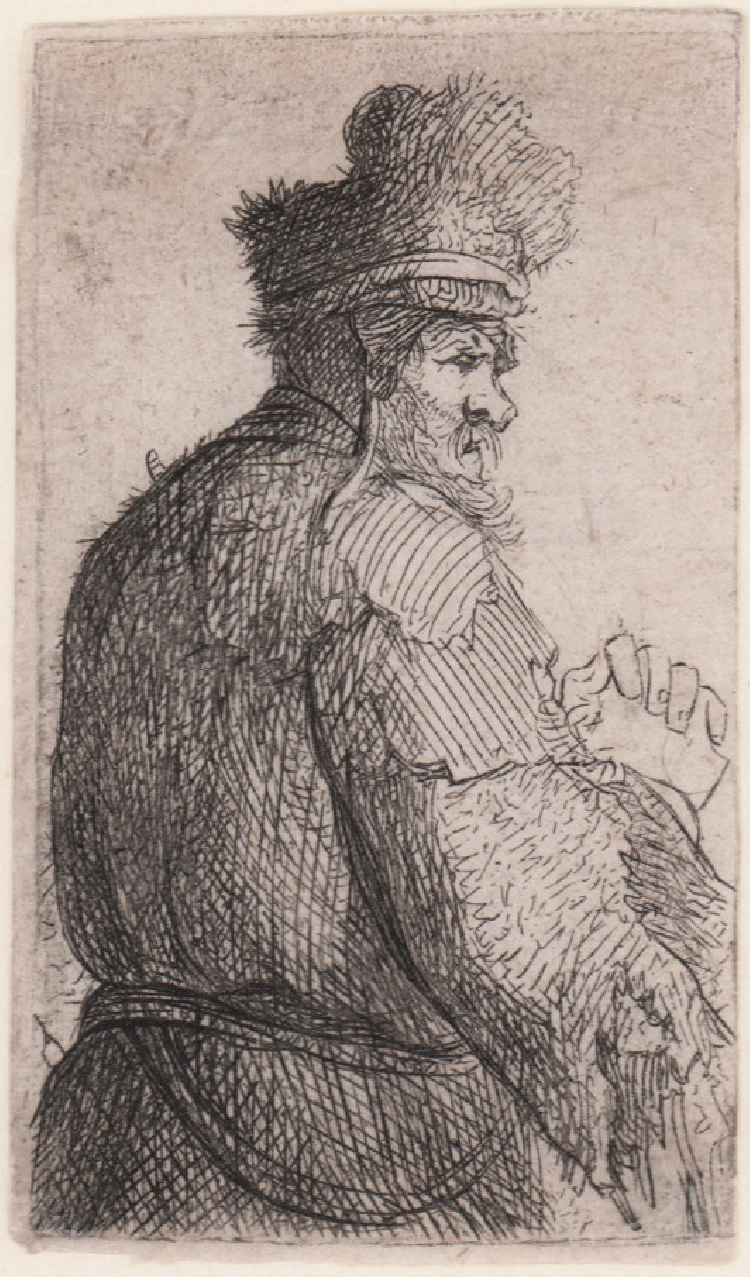




| Reference: | S40249 |
| Author | Harmensz van Rijn detto REMBRANDT |
| Year: | 1630 |
| Measures: | 42 x 72 mm |



| Reference: | S40249 |
| Author | Harmensz van Rijn detto REMBRANDT |
| Year: | 1630 |
| Measures: | 42 x 72 mm |
Etching, circa 1630-31, unsigned and undated.
Example of the fifth state of six (Nowell-Ustike) or the third state of four (White & Boon).
A good example, printed on contemporary laid paper, with thin margins or trimmed to the platemark, a small reapired areas at the lower right cornerm otherwise perfect condition.
Old man seen from behind, in profile to right, half-figure with clasped hands; fifth state with plate cut, cross-hatching added to coat and new lines on upper part of ear flap.
This is an impression of a fragment cut from a larger plate (two complete impressions of this state are in Paris and in the Albertina, Wien).
The plate was cut up by Rembrandt; impressions of five different fragements have survived, including this work. According with Nowell-Ustike (that assigns the status of "RR+") this single impressions are dated about 1641.
A rare work.
|
Bartsch, Nowell-Ustike, 143, V/VI; White & Boon 1969 143.III/IV; Hind 1923 41C.V; New Hollstein (Dutch & Flemish) 33a.V (Rembrandt).
|
Harmensz van Rijn detto REMBRANDT (Leida 1606 - Amsterdam 1669)
|
Born in Leiden, Holland in 1606, Rembrandt studied with Jacob Isaacsz van Swanenburgh (1571-1638) and Pieter Lastman (1583-1633). By 1626 he was an independent painter, working in Leiden alongside Jan Lievens (1607-74), another pupil of Lastman.
In 1631 Rembrandt moved to Amsterdam where he painted portraits of wealthy merchants. Three years later, he married his first wife, Saskia, and by the end of the 1630s he had moved into a substantial house (now the Rembrandt House Museum). In 1642, the year Rembrandt completed The Nightwatch (Rijksmuseum, Amsterdam), Saskia died.
By 1649, Hendrikje Stoffels had become his housekeeper and partner. Both Saskia and Hendrikje Stoffels posed for many paintings and sketches, often appearing as Susannah, Diana, Flora, Artemisa and other classical or Biblical figures. Rembrandt, however, was plagued by financial troubles and in 1656 his assets were made over to the courts, and many were sold. With his wife and son in financial control, Rembrandt continued to paint. Hendrikje died in 1663, his son Titus in 1668 and Rembrandt himself in 1669.
In his drawings, etchings and paintings, Rembrandt treated every subject: histories, landscapes, portraits, self-portraits, everyday scenes or sketches from nature. Rembrandt's biographer, Cornelis de Bie, praised his paintings, 'which enlighten every mind', and his etchings which are 'the very soul of life that lives therein'.
|
|
Bartsch, Nowell-Ustike, 143, V/VI; White & Boon 1969 143.III/IV; Hind 1923 41C.V; New Hollstein (Dutch & Flemish) 33a.V (Rembrandt).
|
Harmensz van Rijn detto REMBRANDT (Leida 1606 - Amsterdam 1669)
|
Born in Leiden, Holland in 1606, Rembrandt studied with Jacob Isaacsz van Swanenburgh (1571-1638) and Pieter Lastman (1583-1633). By 1626 he was an independent painter, working in Leiden alongside Jan Lievens (1607-74), another pupil of Lastman.
In 1631 Rembrandt moved to Amsterdam where he painted portraits of wealthy merchants. Three years later, he married his first wife, Saskia, and by the end of the 1630s he had moved into a substantial house (now the Rembrandt House Museum). In 1642, the year Rembrandt completed The Nightwatch (Rijksmuseum, Amsterdam), Saskia died.
By 1649, Hendrikje Stoffels had become his housekeeper and partner. Both Saskia and Hendrikje Stoffels posed for many paintings and sketches, often appearing as Susannah, Diana, Flora, Artemisa and other classical or Biblical figures. Rembrandt, however, was plagued by financial troubles and in 1656 his assets were made over to the courts, and many were sold. With his wife and son in financial control, Rembrandt continued to paint. Hendrikje died in 1663, his son Titus in 1668 and Rembrandt himself in 1669.
In his drawings, etchings and paintings, Rembrandt treated every subject: histories, landscapes, portraits, self-portraits, everyday scenes or sketches from nature. Rembrandt's biographer, Cornelis de Bie, praised his paintings, 'which enlighten every mind', and his etchings which are 'the very soul of life that lives therein'.
|